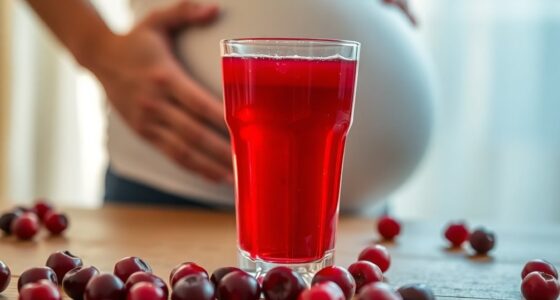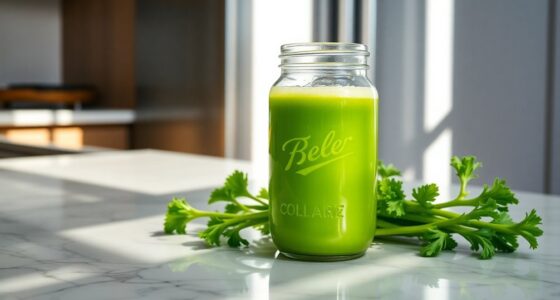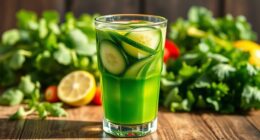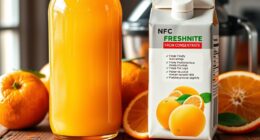Homemade juice is good for about 24 to 72 hours when stored properly in the fridge. You'll enjoy the best flavor and nutrients within the first 24 hours. If you use a twin-gear juicer, your juice can last up to 4-5 days, while a centrifugal juicer may only keep it fresh for about a day. Storing your juice in airtight glass containers can help maintain its quality. Want to know more tips on maximizing your juice's lifespan?
Key Takeaways
- Homemade juice typically lasts between 24 to 72 hours when stored properly in the fridge.
- Twin-gear juicers can extend juice freshness up to 4-5 days, unlike centrifugal juicers, which last about 24 hours.
- Using fresh, organic fruits and vegetables enhances juice longevity and prevents quicker spoilage.
- Store juice in airtight glass containers, filled to the brim, to minimize air exposure and preserve quality.
- Leftover juice can be frozen for up to 6 months, but optimal taste is best within the first 3 months.
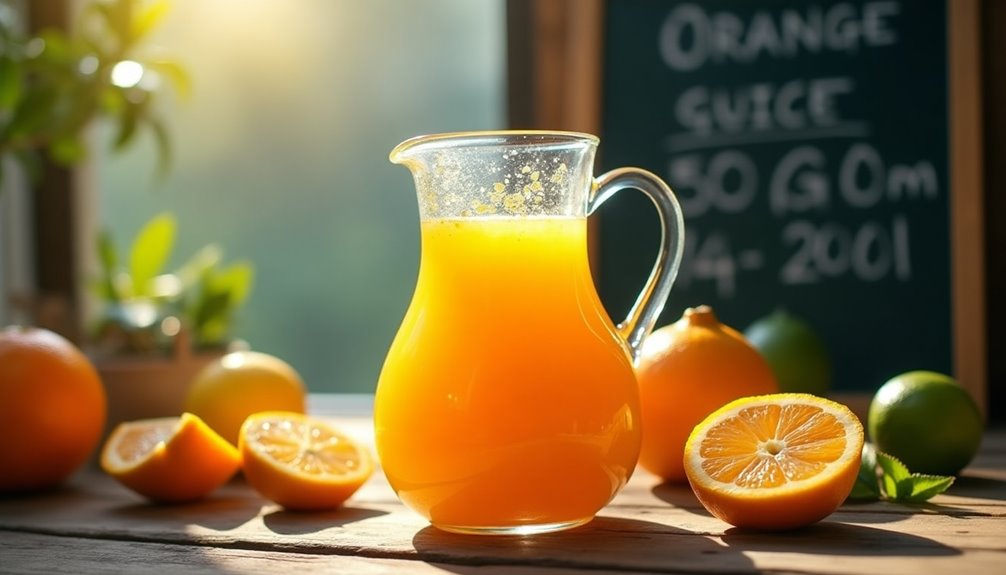
When you whip up a batch of homemade juice, you might wonder how long it stays fresh and tasty. The truth is, the shelf life of homemade juice can vary based on multiple factors, including the type of juicer you use and how well you store it. Generally, when stored properly in the fridge, your juice should last between 24 to 72 hours. However, for the best flavor and nutrient content, aim to drink it within the first 24 hours.
The type of juicer you use plays a significant role in how long your juice remains fresh. If you're using a twin-gear juicer, you're in luck! This type can help your juice last up to 4-5 days due to its efficient extraction process. On the other hand, if you're using a centrifugal juicer, you might find that your homemade juice lasts only about 24 hours. The higher oxidation levels from centrifugal juicing can accelerate spoilage, so keep that in mind when deciding how to store fresh juice.
Using fresh, organic fruits and vegetables can also enhance the longevity of your juice. Overripe or damaged produce can lead to quicker spoilage, so always select the freshest ingredients. When you make your juice, consider the quality of the fruits and vegetables you’re using; their condition can significantly affect how long your homemade juice lasts. In addition to prolonging the freshness of your juice, using high-quality ingredients ensures that you’re maximizing the nutritional benefits. This raises an important question: how nutritious is Naked Juice? While Naked Juice promotes itself as a healthy option, it’s essential to compare its nutritional content with that of freshly made juices to see which offers more vitamins and minerals for your daily intake. By prioritizing fresh, organic produce, you not only enjoy a delicious beverage but also pack it with the essential nutrients your body needs.
Storing your juice properly is another key factor in maintaining its freshness. Place your juice in airtight containers, preferably glass, and fill them to the brim to minimize air exposure. Oxygen can degrade the quality of your juice, so reducing the amount of air in the container is crucial. When you do this, you're taking a significant step towards preserving the flavor and nutrient content of your delicious drink.
If you find yourself with leftover juice that you can't consume within a few days, freezing juice is an excellent option. You can preserve homemade juice for up to 6 months in the freezer, although it's best to enjoy it within the first 3 months for optimal taste and nutrition.
When freezing juice, make sure to leave a little space at the top of the container, as liquids expand when frozen. This way, you won't risk any spills or broken containers.
Frequently Asked Questions
How Long Does Homemade Juice Last in the Fridge?
When you make homemade juice, it typically lasts between 24 to 72 hours in your fridge, depending on how you store it.
If you use an airtight container and keep your fridge at the right temperature, you can enjoy it longer.
Juices from twin-gear juicers might last 4 to 5 days, while those from centrifugal juicers usually stay fresh for about 24 hours.
For the best taste, drink your juice within the first day!
Can You Drink Juice After 7 Days?
You might think it's okay to drink juice after 7 days, but it's not safe.
Homemade juice, especially if unpasteurized, can spoil and lead to foodborne illnesses. You should always check for signs of spoilage, like a strong odor, discoloration, or sour taste.
If you notice any of these, toss it out. It's better to be safe than sorry, so enjoy your juice fresh within a few days for the best flavor and safety!
How Long Does Homemade Juice Last in a Mason Jar?
Homemade juice stored in a mason jar typically lasts between 24 to 72 hours in the fridge.
To keep it fresh, fill the jar to the brim and seal it tightly to minimize oxygen exposure.
You'll want to keep the refrigerator temperature between 35-40°F (1.6-4.4°C) for best results.
If you need longer storage, consider freezing the juice, which can last up to 6 months, but aim to drink it within 3 months for optimal flavor.
Can You Drink 4 Day Old Juice?
You might be tempted to enjoy that 4-day-old juice, but it's not the best idea.
After a few days, the juice can lose its freshness and nutrients, turning into something less than delightful. You could encounter unpleasant odors or sour flavors, which hint at spoilage.
For your health and taste buds, it's wise to stick to drinking juice within 72 hours of making it. Your body will thank you for it!
Conclusion
In the end, the freshness of your homemade juice often hinges on how you store it. Coincidentally, just as you savor the vibrant flavors of your creation, it's best consumed within 24 to 72 hours for optimal taste and nutrition. So, whether you sip it during a sunny afternoon or share it at a gathering, remember that your juice is at its peak when it's fresh. Enjoy those moments, but don't let them linger too long in the fridge!
Cindy thoroughly researches juicing trends, techniques, and recipes to provide readers with practical advice and inspiration. Her writing style is accessible, engaging, and designed to make complex concepts easy to understand. Cindy’s dedication to promoting the advantages of juicing shines through her work, empowering readers to make positive changes in their lives through the simple act of juicing.




